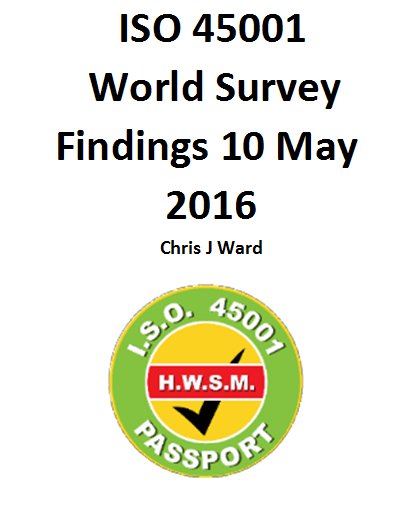Standards in focus: What the world thinks of ISO 45001
This article was written prior to the announcement that publication of ISO45001, the new international occupational health and safety standard, may be delayed until June 2017.
Curious about what occupational health and safety standard ISO 45001 could mean for you or wondering what others in the profession are thinking? This survey’s findings gives an insight into the level of understanding of the new standard and the problems organisations can foresee in trying to implement it.
Conducted by Chris J Ward and carried out between February and April 2016, the survey, in the form of a questionnaire, was completed by over 450 LinkedIn health and safety practitioner members worldwide.

The respondents were asked their country of origin, size of organisation, their understanding of the key statements in the standard, its relevance to their organisation, their current level of implementation of OHSAS 18001 and their intention to adopt it based on the draft standard.
The survey was completed by a global audience: 17% UK, 11% USA, 11% Australia, 6% Canada, 4% India, 4% South Africa, the balance of 47% covering responses from a further 64 countries. The size of organisation, on an employee basis, covered a spread of: 35% < 100, 20% 100 – 500, 14% 500 – 1000, 13% 1000 – 3500, 4% 3500 – 5000 and 15% > 5000. The country of origin referred to the base for their head office.
Chris knows that many who completed the survey were global organisations with divisions in many countries. A good number were high ranking Fortune 500 and FTSE 100 companies. When assessing the effect, or footprint of the standard, these organisations will be responsible for significant preparation through their supply chain and stakeholders
At the present time 52% of those organisations are using OHSAS 18001. However in response to the question “Are you in favour of adapting it (45001) for your organisation?” 69% were in favour, 6% were against and 25% undecided. This would indicate that a significantly larger number of respondents are intending to implement the new standard. It is unlikely that the existing 18001 compliant organisations will not wish to migrate (OHSAS 18001 will be withdrawn when 45001 is introduced; there will be a 3 year window to transit). When direct knowledge of ISO 45001 was tested by asking the understanding of key phrases quantified by a sliding scale of 5 to 1 (where 5 was definite understanding and 1 represented no understanding) the results were as follows:
- Top management commitment: 5 – 63%, 4 – 30%, 3 – 5%, 2 – 2%, 1 – 0%
- Context of the organisation: 5 – 39%, 4 – 34%, 3 – 18%, 2 – 8%, 1 – 1%
- Risk based approach: 5 -55%, 4 – 30%, 3 – 12%, 2 – 2%, 1 -1%
- Worker involvement: 5 – 60%, 4 – 27%, 3- 8%, 2 – 3%, 1- 2%
These results seem to indicate the need for the standard to be explicit in its requirements for these important clauses, and less vague in its general directives, such that all organisations have a clear defined standard for compliance.
The question for the relevance for ISO 45001 for organisations that have less than 50 employees on a sliding scale of 5 to 1 (5 very relevant, 1 not at all relevant) was seen as follows: 5 – 28%, 4 – 26%, 3 – 29%, 2 -12%, 1 -5%. This will surprise some observers who consider these Integrated Management Standards as relevant only to larger businesses. The drafting committee have always tried to simplify the terms and requirements to make them more understandable and accessible to smaller bodies. Time will tell if they have succeeded. These smaller organisations will be relying on outside expertise. They will need clear simple guidance (Chris spent a lot of time in HSE trying to do this, and he said it is not easy!). For the future there will be increasing use of software applications which these smaller concerns can adopt. It remains to be seen what auditors will make of that approach.
This was a rolling survey with new respondents being included and updated in the results. However there was remarkable consistency in the answers to the questions. The current profile (450 respondents) is almost identical to the profile after just 100. This limited variance gives much validity to the results.
It would appear then that 45001 holds great appeal for international organisations. This is could be not only because ISO has more universal appeal than national standards, but also because this standard is the natural successor to what many see as an enhancement of 18001 (which has over 90,000 organisations working to its requirements). Also, it is an integrated management standard, so those already working to 9001 and 14001 should already have systems in place to achieve 45001, without further significant expenditure. This standard transcends regional boundaries which is important to the increasing globalised nature of organisations. Furthermore there is a growing acceptance that the costs of compliance are less than the costs of failures. Those costs are not just financial but also reputational, ethical, social and moral. One only needs to remember Deepwater Horizon to understand those issues.
In line with changes of philosophy and policies of governments, however reluctantly in the face of international pressure, there is a change of attitudes to worker’s rights, management responsibility and corporate ethics. Perhaps 45001 has arrived at a point in time when it is seen as meaningful, relevant, achievable and necessary
The content of this survey has been used by David Smith, chairman of the ISO group responsible for producing the standard.
You can still take part in the survey, doing so will update the results. But it will also give you the chance to benchmark yourself (in confidence) against the survey population.

Chris J Ward’s LinkedIn EHS ISO 45001 Group here
Chris’s website where you can read much more on the standard here
Chris has since created a survey for consultants and trainers to encourage them to have the appropriate resources and approaches to help the smaller organisations in particular achieve ISO 45001.
Chris J Ward is a member of BSI OHSAS 18001 Committee and has contributed to the drafting of the standard. Prior to retiring from HSE, the UK regulator, he revised the current edition of HSG 65 Managing for Health and Safety, which was the original basis for 18001. He was in the Inspection and Investigation division for 37 years.
Standards in focus: What the world thinks of ISO 45001
This article was written prior to the announcement that publication of ISO45001, the new international occupational health and safety standard,
Safety & Health Practitioner
SHP - Health and Safety News, Legislation, PPE, CPD and Resources Related Topics
Navigating the future: EHS workforce and training in a new era of tech
Your Chance to Put Your ISO 45001 Questions to the Experts
Arco clothing centre receives ISO 45001 certification



Informative article.. gives info on what ISO 45001 is all about…